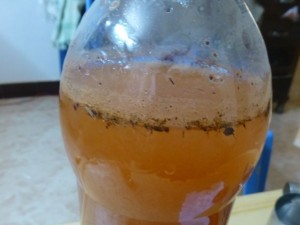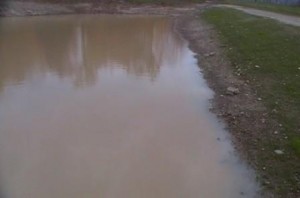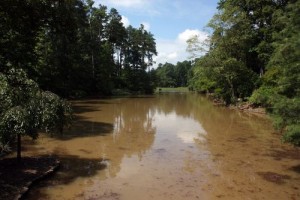 Causes, Prevention, and Remedies
Causes, Prevention, and Remedies
All ponds and small lakes can become muddy on occasion due to inclement weather. In most cases, these muddy conditions are short-lived and will clear in several days if no further rainfall occurs. Occasionally, a pond will become muddy and will fail to clear. These situations may necessitate measures to eliminate the turbidity and prevent future occurrence. Muddy water, as described in this sheet, is caused by soil particles (typically clay) and is usually a chocolate brown color. Water that is green in color is caused by an algae bloom as a result of excessive nutrients.
Impact of Muddy Water
Many ponds are built to provide recreational activities and aesthetic benefits. Chronically muddy water makes a pond very unattractive and most swimmers will avoid swimming in such water. Fishing is impacted because a chronically muddy pond reduces the amount of sunlight penetrating into the water which in turn reduces the amount of aquatic food produced by the pond’s food chain. This ultimately reduces the amount of fish biomass that can be supported. Additionally, desirable fish species such as bluegills and largemouth bass are sight feeders. High turbidity levels negatively impact the ability of these species to feed and maintain themselves in a healthy condition.
Causes
Biological factors
 The two primary biological causes of muddy water are fish and waterfowl (ducks and geese). Large populations of common carp, goldfish, and bullheads can cause muddy water due to their spawning and feeding activities in shallow water. The constant splashing and rooting around in shallow water not only causes re-suspension of bottom soils, but is detrimental to shallow water vegetation that helps protect shorelines from wind-induced wave action. Large numbers of domesticated ducks and geese cause similar problems. Additionally, waterfowl often eat bank vegetation which can increase erosion.
The two primary biological causes of muddy water are fish and waterfowl (ducks and geese). Large populations of common carp, goldfish, and bullheads can cause muddy water due to their spawning and feeding activities in shallow water. The constant splashing and rooting around in shallow water not only causes re-suspension of bottom soils, but is detrimental to shallow water vegetation that helps protect shorelines from wind-induced wave action. Large numbers of domesticated ducks and geese cause similar problems. Additionally, waterfowl often eat bank vegetation which can increase erosion.
Watershed factors
Activities in the watershed are a leading cause of muddy ponds. Ponds that receive runoff water from nearby soils that are frequently disturbed with agricultural equipment are prone to be muddy. This is particularly true if farming is done right up to the pond bank. Another agricultural activity that causes muddy ponds is allowing livestock access to the pond. The frequent trips to drink cause considerable disturbance in shallow water. Construction within the pond’s watershed can also result in considerable input of suspended clay into a pond. A watershed that is too small for the size of pond it flows into can cause muddy water due to wave action along exposed mud shoreline as water levels drop during periods of low rainfall.
Prevention
Prevention is the key to eliminating the need for costly remedial action to clear a pond.
Biological factors
 Do not stock and prevent the introduction of carp, goldfish, and bullheads into the pond. A major source of these nuisance fish species is the bait bucket. It is not unusual to see carp and bullhead fingerlings in buckets of minnows. If the bait bucket is dumped into the pond, a muddy water problem may develop. Many pond owners prohibit fishing with minnows or any bait fish.
Do not stock and prevent the introduction of carp, goldfish, and bullheads into the pond. A major source of these nuisance fish species is the bait bucket. It is not unusual to see carp and bullhead fingerlings in buckets of minnows. If the bait bucket is dumped into the pond, a muddy water problem may develop. Many pond owners prohibit fishing with minnows or any bait fish.
Maintain dense populations of largemouth bass. This predator species can control nuisance fish species in ponds.
Try to keep domestic geese and ducks away from the pond. One pair per surface acre is tolerable, but anything more could lead to a problem. The expanding Canada goose population often causes muddy water problems.
Watershed factors
- In planning a pond, make sure to match watershed size correctly to pond size. A good rule of thumb is about 10-15 acres of watershed for each surface acre of pond. Except in case of drought, this should keep the pond “bank full” and minimize turbidity from wave action.
- Try to maintain vegetative cover throughout the watershed. If the watershed is largely agricultural, muddy water can be prevented by maintaining most of the watershed in hay crops rather than field crops.
- If hay crops are not an option or the pond owner does not control all the entire watershed, maintain a wide buffer strip of vegetation around the pond. Typically, buffer strips of 100-150 feet are suggested.
- Establish and encourage moderate vegetative growth around the pond edge. Shorelines that have areas of rushes, sedges, and cattails are better protected from wave action and therefore less likely to add clay particles to the pond.
- It is important to fence livestock away from the pond to prevent erosion of the pond bank and disturbance of shallow water soils.
- If construction must occur in the watershed, timely completion and immediate reseeding of the affected areas can prevent a long-term muddy water problem.
Remedies
Biological factors
If nuisance fish species are already present and causing muddy water, they need to be removed. Either drain the pond and remove them or treat the pond with a fish toxicant to eliminate the fish community. Restock with desirable species. If nuisance species are present but water clarity is acceptable, be sure to maintain a dense population of largemouth bass to ensure future control of the nuisance fish species. This can be accomplished by limiting harvest of the bass.
Keeping Canada geese away from ponds is becoming increasingly important as their population increases. If geese have caused a muddy water problem, harassment tactics are an option used by many. They range from air cannons to scare the birds away to dogs (border collies are often used) that continually harass the birds until they leave. There are also products on the market that make the vegetation and lawns around the pond unpalatable to geese. If they do not like the taste, they will eventually leave to find food elsewhere.
Watershed factors
Some watershed activities disturb clay materials that can result in muddy water problems that are extremely difficult to correct. A prime example of this is construction activity in the watershed. Colloidal clay particles are very small and can take a very long time to sink to the bottom. If you take a jar of water from your pond and after several days it is still very cloudy in appearance, you likely have a problem with clay particles. Several techniques exist that allow the pond owner to greatly reduce the levels of suspended clay particles. All of these techniques involve the “binding” of clay particles into larger particles which sink to the bottom much faster.
Hay
A time-honored method of removing suspended clay particles is the application of dry hay. Dry hay should not be confused with straw. The hay should be loosely distributed throughout the shallow areas of the pond. Recommended application rates are about 500-550 pounds per acre-foot of water. Consult the Ohio State University Extension Fact Sheet A-2-98, Pond Measurements to correctly estimate your pond’s volume in acre-feet. Quite often a muddy pond will not need the full application to clear the water. You may wish to consider adding about 50% of the required amount, waiting 10-14 days, and then assessing whether additional hay is needed. A good rule of thumb is that if water transparency reaches 18-24 inches deep, enough hay has been added. There is one important reason to use as little hay as necessary. The addition of large amounts of organic material, such as hay, can lead to oxygen depletion as the material decomposes. This is especially true in July and August. If hay application must occur in summer, supplemental aeration may be needed to prevent a fish kill.
Gypsum
Agricultural gypsum is another material for removing suspended clay and does not cause the concern of a fish kill associated with adding hay. Gypsum is also chemically neutral and therefore does not cause possible pH problems associated with alum, another commonly used material. Typical application rates are from 1,000-1,500 pounds per surface acre of water, depending on the severity of the clay suspension. Again, it is wise to add the gypsum at a conservative rate of 250-500 pounds per surface acre of water, wait several days, and determine if additional gypsum is needed. This prevents excessive application and therefore helps keep costs down. Dissolve the gypsum in clean water and spray over the surface on a calm day. Late evening is often an ideal time to make the application as most nights are wind-free. Water movement from the wind prevents the suspended clay from quickly settling out, reducing the effectiveness of gypsum.
Alum (aluminum sulfate)
Alum is the most effective material for clearing clay turbidity from a pond, often within a few hours. Application rates are typically 100-450 pounds per surface acre. As before, add 1/3-1/2 of the required amount, wait a day, and then determine if additional alum is required to increase transparency to about 18 inches. Application procedures are identical to those described for gypsum.
For alum, there is a very good reason to use the minimum amount necessary. After application, there is a chemical reaction that impacts the pH (acidity) of the water. The reaction produces small amounts of sulfuric acid which can decrease pH significantly in some waters to levels harmful to aquatic life.
Therefore, alkalinity and pH should be tested prior to application. Alkalinity should exceed 100 mg/l and pH should be greater than 7.0. If not, hydrated lime needs to be added simultaneously to buffer the effects of the acid produced by the alum addition. Application rate for lime is 50 pounds per acre-foot. It is wise to re-check alkalinity and pH repeatedly as more alum and lime is added. In situations where 400 pounds of alum may be needed, pH may begin to drop quickly even in waters where pH was initially deemed to be adequate for lesser additions. Hydrated lime also removes suspended clay, although not as effectively as alum.
Limestone (calcium carbonate)
Agricultural limestone is a material commonly used to removed suspended clay from the water. Application rates of 500-1,000 pounds per surface acre are typically used. Limestone can be added in the same manner described for gypsum.
If the pond is used for home or livestock drinking water, the use of minerals (alum, gypsum, limestone) is not recommended. The purity of the mineral substances is unknown, and its application to the pond could result in the inadvertent addition of undesirable substances.
Summary
Preventative measures, such as proper pond construction and maintaining well-vegetated watersheds, typically will keep a pond from becoming muddy. Prevention is far less expensive to accomplish than correcting an existing problem or clearing a pond with a variety of mineral substances. However, ponds are occasionally muddy and excessive rainfall is often the general culprit. On rare occasions, a pond will become muddy and not clear up. The first activity for the pond owner is to investigate if a correctable event or condition has occurred. The owner should first examine watershed use, pond shorelines, and the presence or absence of undesirable fish and animal species and assess whether they may have contributed to the muddy water problem. If so, correct if possible and monitor improvements in water clarity. If no improvement is noted, the owner may wish to apply hay or a crushed or powdered mineral to remove the suspended turbidity from the water. It is always wise to start with partial applications to prevent over application and unnecessary expense.
William E. Lynch Jr.
Eric R. Norland
